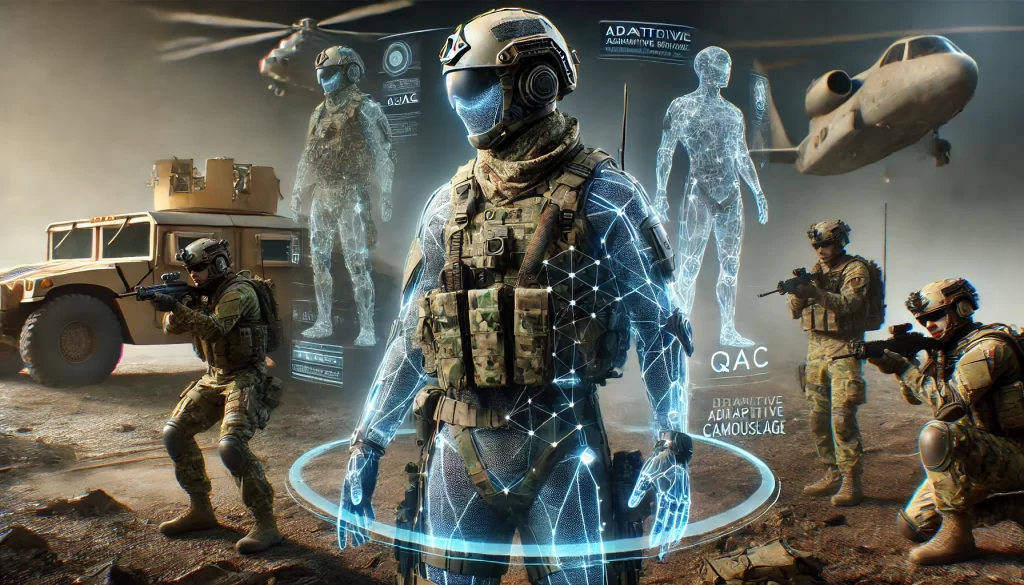
Introduction
The Quantum Adaptive Camouflage (QAC) system is a next-generation stealth technology designed to render soldiers, vehicles, and military bases completely invisible using quantum light manipulation and AI-driven adaptive materials. Unlike traditional camouflage, which relies on colors and patterns, QAC bends light around an object, making it undetectable to the human eye and infrared sensors. This innovation could redefine stealth operations, reconnaissance missions, and battlefield survival, giving soldiers unprecedented advantages in modern warfare.
How QAC Works
The Quantum Adaptive Camouflage system would function through:
- Quantum Light Bending: The suit manipulates photons at a subatomic level to bend light around an object, creating an invisibility effect.
- AI-Driven Adaptive Material: Integrated AI continuously scans the environment and adjusts the material’s properties to blend seamlessly.
- Multi-Spectrum Invisibility: QAC can block detection in visible, infrared (IR), and ultraviolet (UV) spectrums, making soldiers invisible even to thermal and night vision cameras.
- Active Environment Adaptation: The system analyzes nearby textures, lighting, and motion in real time to maintain perfect camouflage.
- Anti-Detection Countermeasures: The suit can emit false signals to confuse enemy radars, motion detectors, and AI-powered tracking systems.
Potential Applications
1. Stealth Operations and Reconnaissance
QAC-equipped soldiers could infiltrate enemy bases undetected, gather intelligence, and evade security measures without leaving a trace.
2. Advanced Vehicle Camouflage
Military vehicles, tanks, and drones coated with QAC material could become invisible to enemy surveillance and airstrikes.
3. Naval and Aerial Stealth
Submarines, fighter jets, and aircraft carriers could utilize QAC technology to remain undetectable even in high-risk zones.
4. Cyber-Warfare and AI Manipulation
By distorting digital signatures, QAC could make cyber assets, satellites, and data transmissions undetectable, protecting critical military information.
5. Civilian and Search-and-Rescue Applications
QAC could assist disaster relief teams by making first responders blend into environments, allowing them to approach wildlife or unstable rescue sites unnoticed.
Challenges and Ethical Concerns
- Energy Consumption: Manipulating light at the quantum level requires huge power efficiency breakthroughs.
- AI Precision and Lag Issues: The system must adjust in real time without delays, or visibility glitches could expose soldiers.
- Potential for Misuse: Criminal organizations or terrorists could weaponize this technology for illegal activities.
- Ethical Warfare Implications: QAC could lead to invisible assassinations, undetectable attacks, and new military doctrines on warfare.
Future of QAC
Advancements in quantum mechanics, nanotechnology, and AI could make QAC:
- Lighter and More Energy-Efficient with graphene-based nano-surfaces.
- Integrated with Neural-Linked Combat Systems (NLCS) for mind-controlled camouflage switching.
- Adaptable to Civilian Security Uses such as police uniforms that turn invisible during high-risk operations.
- Capable of Disrupting AI Vision Algorithms to counter future AI-powered battlefield surveillance systems.
Conclusion
The Quantum Adaptive Camouflage (QAC) system represents a revolution in stealth warfare, merging quantum mechanics, AI, and advanced materials to make soldiers and military assets completely invisible. While still in development, breakthroughs in photonics, nanotechnology, and AI processing power could make QAC an operational reality within the next few decades. However, its ethical implications, security risks, and energy demands must be carefully addressed before deployment.
